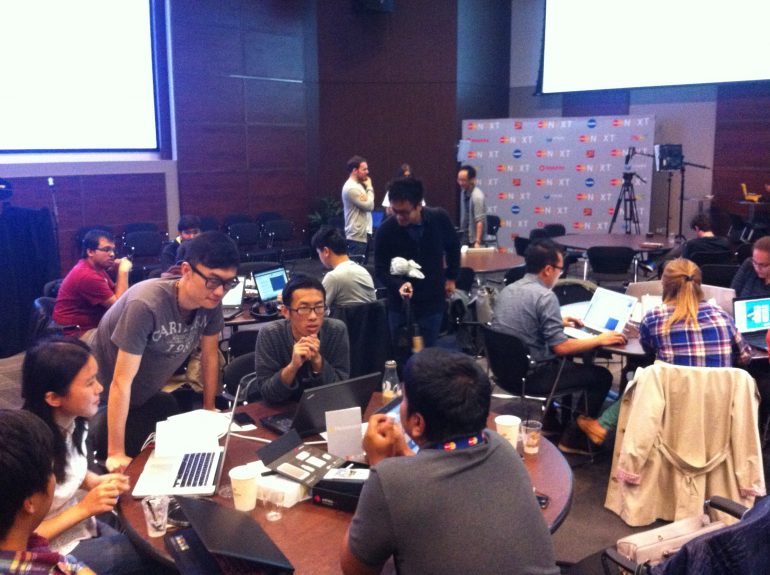Update: The two “student” teams heading to the semifinals are “The Coyotes” and “Paymint”, both teams we previewed in this article (we didn’t know they’d make the cut, seriously)
Meanwhile the three “professional” teams heading to the semifinals are YesTap, Space Bears and Adjoining Dipsticks. All of the semi-finalists will pitch to a judging panel including: Daniel Bader (Mobile Syrup), Jeppe Dorff (Rogers), Todd Roberts (CIBC), Alex Baker (Relay Ventures) and Neil Thomas (Google).
We’ve got just a few minutes left before all twenty teams at this weekend’s MasterCard NXT Developer Challenge will execute their two-minute pitches to judges. After that, five semi-finalists will be selected to go on stage and explain how their mobile payments idea should be crowned king.
Two winning teams, one in the “professional” category and the other in the “student” category, will go home with $10,000. Most teams typically use NFC technology within their ideas, or “Near Field Communication”. NFC technology allows smartphones and similar devices like tablets to establish a radio communication with each other by touching them together or bringing them into close proximity.
We took a walk around the room and checked out five different teams developing everything from QR-code enabled mobile purchasing to an NFC technology-based system that uses avatars to engage users. Teams featured students from dozens of universities across Canada, professionals from all walks of life and even one high school-aged team with an impressive track record.
First I spoke with a group of four friends (including a set of twins) from “Paymint”. Victor and Winston Zhang, from the University of Toronto and Queens University, Jeremy Wang from the University of Waterloo and Michael Fok, from the University of Alberta, are developing a new wireless Bluetooth 4.0-enabled, proximity-based mobile payment system.
Using the app and MasterCard’s servers, merchants can send users a charge, and those users can send their payments instantly. Bluetooth technology can detect devices within about 10 metres, and can detect about 20 people at a time in that range, the technology could work well in a live-event capacity. The Air Canada Centre in Toronto already has iPad-wielding waitresses who walk up and down rows taking orders from event-goers. Instead of those fans yelling orders over the seven people between them and the waitress, they could simply use Paymint’s app via their smartphone.
Meanwhile, “The Coyotes” are a group of mostly 11th grade high school students from Toronto’s Crescent School, the only student group participating at the event not containing university pupils. The Coyotes (named because that’s what their school’s mascot is) are developing an app that allows users to make payments via NFC technology on credit cards, while allowing friends to split bills. It’s a paperless solution for merchants that also includes coupons and trivia games to boost user engagement. The team of young coders already won the First Robotics Contest before, with their idea to code a robot that can shoot frisbees across 50 foot fields into small goals.
Next up I spoke to the guys from Triangle.IO, which is an NFC technology API that we profiled last week. App developers who integrate Triangle’s technology can help ecommerce apps avoid the trap-of-death like phase of online commerce where nearly two-thirds of customers will drop out of a buying page when asked to manually enter credit card information. With Triangle’s technology, people simply tap their card to the back of a phone or tablet and the information is automatically entered.
At today’s developer challenge though, Triangle is altering their idea. Essentially they’re creating a mobile wallet app, using the Triangle API, that customers can use today. The mobile wallet idea has yet to fully lift off the ground as developers wrangle with both large telcos and financial institutions to satisfy all parties. Triangle’s idea can satisfy some immediate needs. They’re calling it the Triangle Wallet, a mobile self-checkout system that is focusing on restaurants. Using the app, restaurant goers will see their total cost, they’ll enter a tip and send the payment. A one-time code will appear as proof, which is what the user gives to a server.
“We’re using your device instead of your credit card and getting rid of the terminals. You don’t have to use your pin anymore, you just go to a restaurant, get the total on the bill and you walk out,” said Triangle’s Ameen Tayyebi.
Also included in the app are mobile coupons and rewards from restaurants and cafe’s, as well as an area that keeps all digital receipts intact.
I also spoke with “Karma Police”, a group of four Bengali-Canadian students from York University and the University of Waterloo, who are developing the “Masterbuddy”. The concept of the app is that users can pay for things via NFC technology, and every time a purchase is made an avatar is generated based on the weather at the time. Whether its cloudy and rainr or a sunshine-filled day, a different avatar will be generated. The avatar ideally will make the purchase fun, as users will be rewarded loyalty points every time they buy something, and this will boost retention (which is what MasterCard wants). Eventually users can generate their own avatars and upload them to the servers.
While most developers in general are male, and most of the teams were made up entirely of guys, it was refreshing to talk to the “Mobilify” team, next. Team members Matthew Clark, Christina Shan, Alvin Lee and Mugdha Mulay, all from different Canadian universities, are developing an app that lets users make payments by scanning a QR code through their smartphone camera. It can enable a paperless, self-checkout at a Starbucks or MacDonald’s, and the transaction history in the app remembers payment information.
Now the teams will all head over to the “elevator pitches” section and deliver a two-minute pitch as to why their idea should make it to the semi finals.






